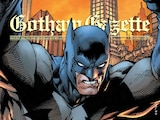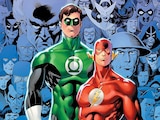Following in the grand tradition of Batman Black and White, Harley Quinn put her own delightfully twisted spin on the limited color concept last year in the DC Black Label anthology series Harley Quinn Black + White + Red. Creators including Harleen writer and artist Stjepan Šejić, Mirka Andolfo, Erica Henderson, Jordie Bellaire, plus veteran Harley creators like Amanda Conner, Jimmy Palmiotti, Chad Hardin and Sam Humphries all contributed memorable short stories in stark black and white accompanied by generous splashes of red.
Harley Quinn Black + White + Red is out now in a collected edition, which includes two never-before-seen stories only available in this format, courtesy of some rather high-profile creative teams: “Eight Nights of Harlequin” by Veep showrunner David Mandel and superstar artist Adam Hughes, and “Harleen’s Half Dozen (Plus One)” by Harley Quinn co-creator Paul Dini and fellow Batman: The Animated Series alumni Kevin Altieri.
Longtime friends Dini and Mandel talked to DC Nation about their contributions to the series and the enduring, ever-evolving versatility of Harley Quinn.

The two of you go quite a ways back. How long have the two of you been friends?
Paul Dini: I was sneaking onto the Seinfeld set one night and David kept me from being shot by security guards.
David Mandel: I moved out to LA in ’95, and I went to work on Seinfeld. I think (we met) that year or later that year.
Both of your contributions to the anthology have a holiday theme. What can you share about how these short stories developed?
Dini: My story is a caper and those are down to being planned in intricate detail. It’s Harley and a group of female criminals pulling a heist. It was all a matter of fitting the puzzle pieces together, with Harley as the screwball leader of the gang. The plan shouldn’t have worked, because she’s just too wild, but it does. Or…it works well enough.
Mandel: They asked me to do a holiday story and I thought I would do a Hanukkah story, because those are few and far between. I figured, who better to explain Hanukkah than Harley? In talking to Paul, he reminded me that she’s half-Jewish and once I had that, I was off to the races. As we all know, nothing says the holidays like a good Hanukkah story in June.
People might accidentally read my story while they’re looking at Adam’s art.

David, you purchased all of Adam’s original art from this story, correct?
Mandel: I kinda had to do it. Once I saw the first page or two, it was just like, oh man, I gotta get this. To have a complete story, so that I can page through the art the way you get to page through the comic—that’s pretty cool.
Paul, did you come up with the idea and then reach out to Kevin, or did you go to him right from the get go?
Dini: I came up with the idea first and then I was thinking, “Boy, it would be really great to work with somebody from the animated series on it.” Kevin has such a manic edge to him. He draws Harley great, he understands terrific animation and he really got the animated sense that I was going for. It was like looking at his storyboards back in the day. It had that sort of energy. He was able to take it to a different level.
There are times when I’ll write a comic book script and I’ll go, “Well, I’ll need eight panels in this page, and it might make it a bit clunky, but maybe they can fit everything in.” Kevin said, “I cut this and this, and put everything in this one panel…” Great. That’s brilliant. He made it sing really well. The intent and humor of everything I was going for was all there.

Paul, you must be rather far through the looking glass of seeing different versions of Harley Quinn since the character debuted, but it still feels notable to see her headline a series like this. After Batman, Harley was the first character to star in a Black and White-type anthology at DC. What’s it like to see Harley stand up to this type of reinvention and reinterpretation?
Dini: It’s gratifying to know that there is a certain spark that’s always been with the character—“I can take anything and keep going.” A sort of daffy optimism mixed with this real reckless side of her that people respond to, especially creators. They can do a darker Harley story and then they can do something that’s just over the top and it always seems to work.
Mandel: When I first started thinking about what to do, just the notion of “which Harley?” was kind of wild because there are very few characters that exist in so many different ways and yet are the same. You can do something set more in the animated world. You can embrace the current version. Where I got to was, it’s a realistic but cartoony story. It worked in a weird way. It was really fascinating that she allows all of that.
The Harley Quinn Black + White + Red collected edition, featuring nineteen stories including “Eight Nights of Harlequin” by David Mandel and Adam Hughes and “Harleen’s Half Dozen (Plus One)” by Paul Dini and Kevin Altieri, is now available in both print and as a digital collection.















